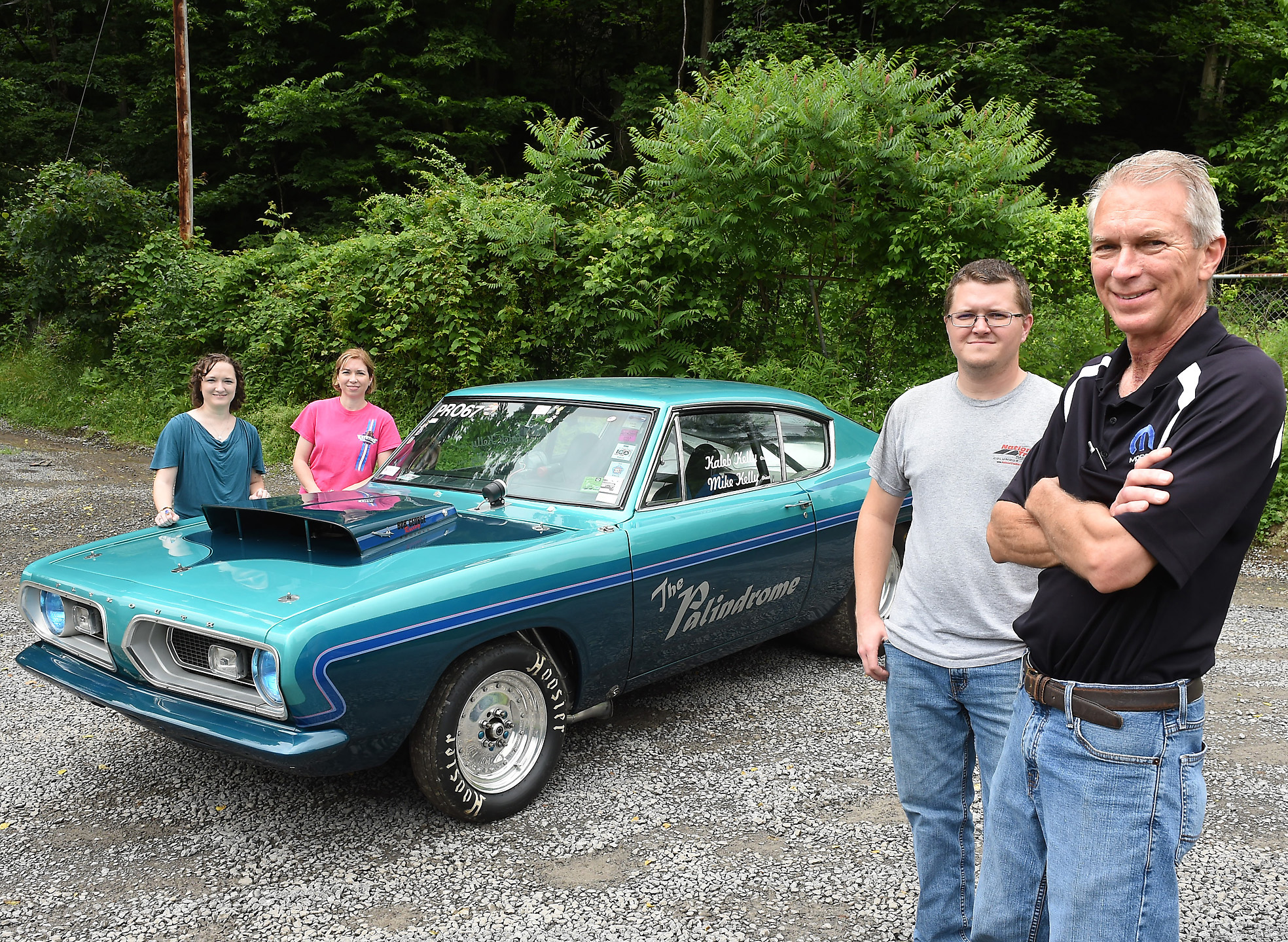Mike Kelly, the Monongalia County Board of Education member, loves taking people to school when the light changes.
He punches it – and he’s off to the races.
Don’t think for one minute that he’s being reckless or irresponsible, however.
“I drive the speed limit, honest,” he’ll say with a chuckle. “Sometimes I go below the speed limit. I faithfully obey all traffic laws.”
On the roads he shares with school buses and other motorists, he means.
Get him on a sanctioned, pro-level, quarter-mile drag strip, though, and watch what happens.
Watch how he pushes his 1967 Plymouth Barracuda to its very limit.
The “Christmas tree” lights click down to green and so does he.
A 500-cubic engine and its nearly 800 horses roar with Detroit decibels and all the torque in the world.
For Kelly, it’s a windshield full of sky for the first three seconds or so.
That’s because the car’s front wheels actually lift off from the thrust and velocity of all.
The flight path is that quarter-mile: 1,320 feet, in just under 10 seconds, as run by Kelly in a certain Barracuda with a literary tag.
“Yeah,” he’ll say, with that chuckle, again. “I tell everybody I like to relax – at 135 mph.”
Ohio, in the passing lane
This past weekend in Winfield, Putnam County, he and Kaleb got to relax with a roomful of kindred spirits who know exactly what it’s like to rocket off the line.
The elder Kelly was inducted into the West Virginia Drag Racers Hall of Fame. He and other members of the Class of 2020 joined with their fellow inductees from ’21 in the combined ceremony.
“COVID really put the brakes on last year,” said Jim Winters, a racing enthusiast who founded the hall eight years ago with his childhood friend Gary Jarvis.
“We had to cancel. So we decided to combine the two classes this year. We want these guys getting the recognition, because they’re the ones who are keeping this thing going.”
The buddies grew up RPM-obsessed in Winfield, and, as it turns out, their tiny hometown loomed large in drag racing in the late 1950s.
Detroit auto-makers were still the big dogs back then, cranking out big cars with big engines that couldn’t help but entice any self-respecting shade tree mechanic with a tantalizing question: “I wonder how much faster I can get this thing to go?”
Putnam County pegged the meter, because it’s only a couple of counties over from Ohio.
Jarvis explains.
“Everybody talks about California and the car culture and all that, but for years, Ohio was second the nation only to California when it came to drag racing.”
And?
“You had 26 dragstrips in Ohio – every single one closed on Sundays,” he said,
This, in what was essentially a weekend sport, he said. Guys wanted to run before they had to go back to work.
“Well, in ’58, people put in a track just outside here, and it was open on Sunday,” Jarvis continued.
“Only one in the region. So, it was like the Ohio racers made us part of their circuit.”
The visibility got people interested in racing who might not have been otherwise.
Driver education
Kelly, who grew up in Westover, made Fairmont’s famed Eldora Raceway – which is now an industrial park – his home track when he was coming up in the sport.
His dad, Oliver, was his biggest influence. The patriarch turned wrenches in World War II when he was shouldering a rifle on the battlefields of Europe.
When he came back home and started a family, he was pleased that young Mike wanted to do what he did. There was always a motorbike to wind out on a path behind the house, or a lawn mower to tune up.
“My dad would always say the same thing. ‘I’m not fixing this for you. I can explain to you how to do it and answer questions, but you’re doing the work.’ And that is how you learn.”
Same for Kaleb Kelly, Mike’s son, who is adept both behind the wheel and under the hood of their car that’s been known to scorch the quarter-mile at speeds up to 140 mph.
Rolling back the odometer
Even with those speeds, Mike Kelly still brings it down to appreciate the time with this son on their shared hobby.
They’ve spent lots of weekends running the ‘Cuda on tracks from Pennsylvania to Tennessee.
“It’s a family sport,” he said.
“That’s what I like about it. You meet so many good people out at the track. And we all help each other out.”
Winters says the same.
“The West Virginia tracks are gone now, and a lot of our inductees are 80, 90 years old. But their kids and grandkids have taken it up. Going into this little hall is a big deal for them.”
TWEET @DominionPostWV




